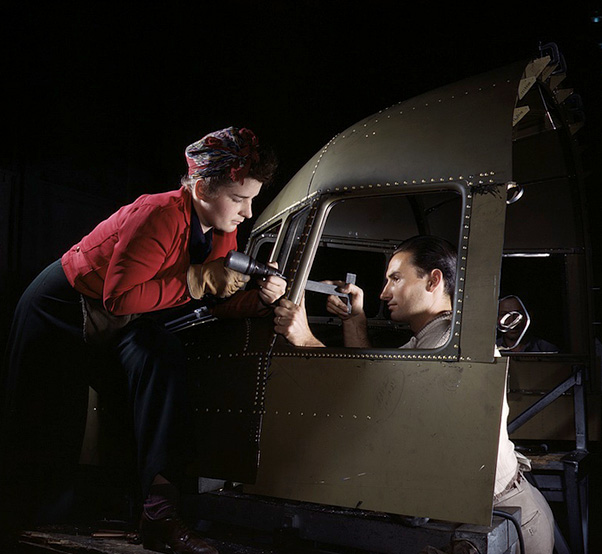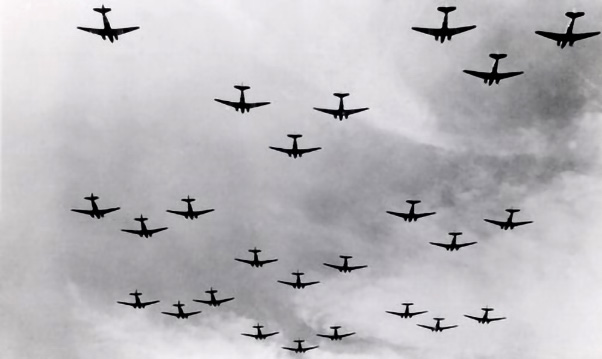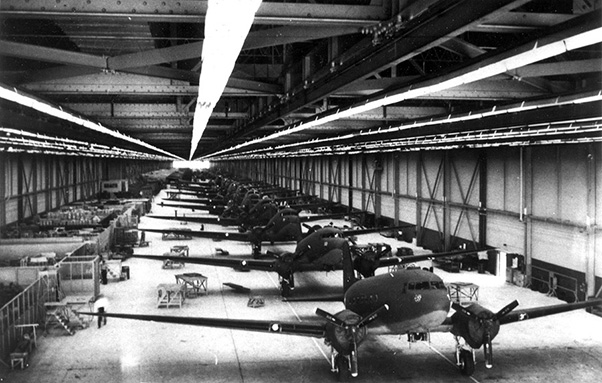by Bob Alvis, special to Aerotech News
With Memorial Day coming up and the anniversary of D-Day immediately after, I went looking for a story that would bridge these two events in an aviation-related manner. After much searching, an old photo in my Dad’s collection, from his Douglas Aircraft Company days, caught my attention. It had something scribbled on the back about an old workhorse that had seen many flight miles, serving the nation in a time of war.
When the war clouds in Europe started to swirl around, the U.S. Army Air Corps knew it would need air transports that would be tasked with unthinkable missions, that would play a major part in the winning of World War II. Looking to Douglas and its cutting-edge DC-3 that was already in production, it was not long before the requirement and the plane would come together to become one of the great aviation stories of WWII: the amazing C-47 Skytrain transport.
To many in the aviation world, the DC-3/C-47 would be labeled the greatest aircraft of all time. Even today, that old airframe still motors on in many capacities. Looking at that old photo, I remember Dad telling me stories of his involvement with the Douglas production lines back in Oklahoma City and how the work force in middle America managed to push out 13 new C-47s every day. When the final tally was reached, the Oklahoma City plant produced over 5,000 of the 8,000 Skytrains that were built during the war.
As those birds made their way down the assembly lines, I wonder… did those building them ever think about how the skill in their hands was producing a product that would be written about in history books for generations; and how the fortunes of war would be measured in the successes and the losses of the men and women that the Skytrain was being built to serve? That old photo I have says on the back, “A warrior comes home from the battlefields of Europe in its well-earned battledress, showing the scars of working the skies in combat.”

As a symbol, it represents — as do many of the old warbirds — a generation of men who are now slowly fading into history and will no longer be able to tell their stories. It sits silently, unable to share the stories or the passion of the crews that served aboard it, relied upon it, or lost their lives flying it.
As we get ready to mark another passage of D-Day on June 6, we recall the stories we’ve been blessed with over the years of those brave Airborne troops who would board these planes in the early morning hours, to fly into the unknown that would define them for the rest of their lives. We also remember the crews that were also flying into the unknown carrying the precious cargo of American youth — either to transport them to the battlefield, or set them on the first steps of their return to America, to family and loved ones living in a free world.
But many of these brave soldiers and aircrews would not survive those D-Day missions. Acts of heroism would not be rare, as the men would find in their last moments of life the ability to overcome terror and give others a fighting chance to live. Thinking about these moments, we can also look to those back in America on the assembly line who were also fighting to save these lives, with the skills and dedication of building an aircraft that could withstand brutal punishment and give the crews a chance for survival. Each aircraft carried not only its cargo, but it carried the fighting spirit of America in all aspects of its mission — from “Rosie the Riveter,” to the aircrews and finally, the men that would exit into the unknown.
The number of air transports involved on D-Day and days after numbered over 850. Many of those old workhorses would only make a one-way trip, as did many of the aircrews and paratroopers. Some of the stories surrounding those last moments leave us in awe of the bravery of our American fighting men when the time comes to be accounted for. Just the narrative of one such plane lost that morning speaks to all those lost on that day: the final moments of Oklahoma-built C-47 42-100876 and 2nd Lt. Marvin F. Muir on June 6th, 1944.

“While approaching the Drop Zone in Normandy at about 0114 hours, Lt. Muir’s C-47 was hit by anti-aircraft fire near the companionway and the baggage compartment aft of the flight deck was almost immediately filled with flames. The plane wavered and then started to pull up straight, as if the pilot were trying to get above the formation and give his paratroopers and crew if possible, an opportunity to jump. Then it looked as though it stalled and fell first on the left wing and then on the right. A few seconds after the original fire, the left engine burst into flame. The plane fell away to the right and went into a dive of about 30 degrees with level wings. Immediately a string of paratroopers were seen to emerge from the doomed plane. At about 150 mph, it hit the ground at an angle and burst into flame in the vicinity of the railroad southeast of Sainte Mere Eglise.”
There were no survivors from the four-man crew, and it would not do them justice if I failed to mention their names: copilot 2nd Lt. Ken C. Hall: crew chief Ssgt. Cliff Burgess, and radio operator Sgt. Philip Snyder, in addition to pilot Muir. As for the 18 paratroopers, only one perished, thanks to the heroic actions of the pilot and crew to keep the plane airborne and give the troopers a chance to get out. It was later stated in his decoration for bravery under fire, “Keeping the C-47 in the air long enough for the paratroopers to hook up and jump at the cost of his own life, 2nd Lt. Muir is awarded the Distinguished Service Cross posthumously.”
Memorial Day is upon us again and stories like this are what inspire many of us attending programs around our communities to not only remember the sacrifices of these brave men and women that put on the uniform of our country, but to also remember the long line of patriots that never put on a uniform, but in their own way, sacrificed to make sure that those who served would have the very best equipment to give them a chance to survive and be victorious.
War mementos, like an old photo in desk drawer or a family heirloom from a relative, are much like the cherished statues around our nation that remind us that potential for heroism is in each and every one of us. Sacrifice must be shared by us all, as we remember that those who gave their lives belong to each and every one of us. It is up to us to carry on their stories of sacrifice.
This Memorial Day I remember the fallen; D-Day; my Dad, and all those who found value in an old workhorse plane they helped to create by the thousands, which served its crews so well to the very end.
Peace my friends, Bob out …










